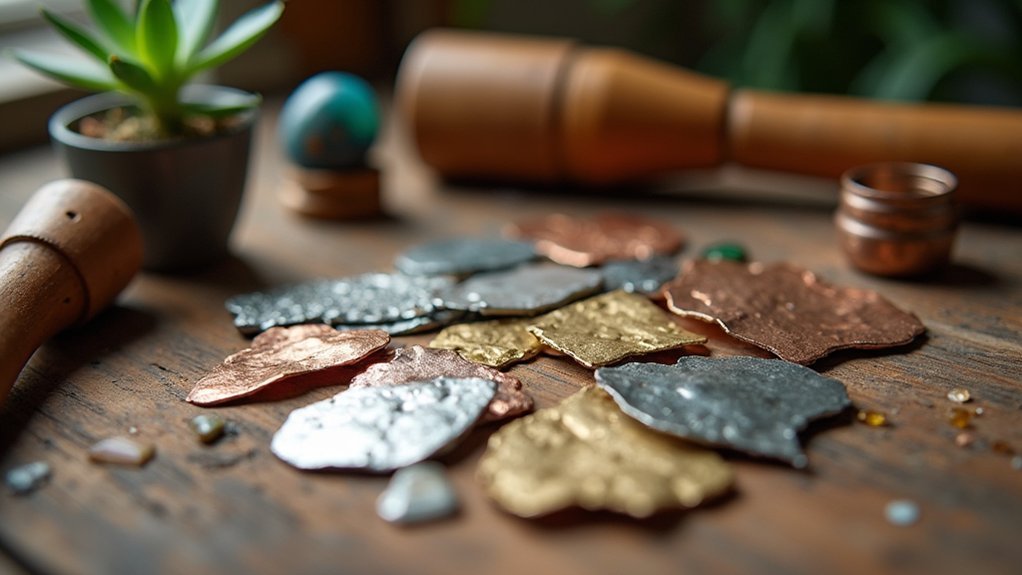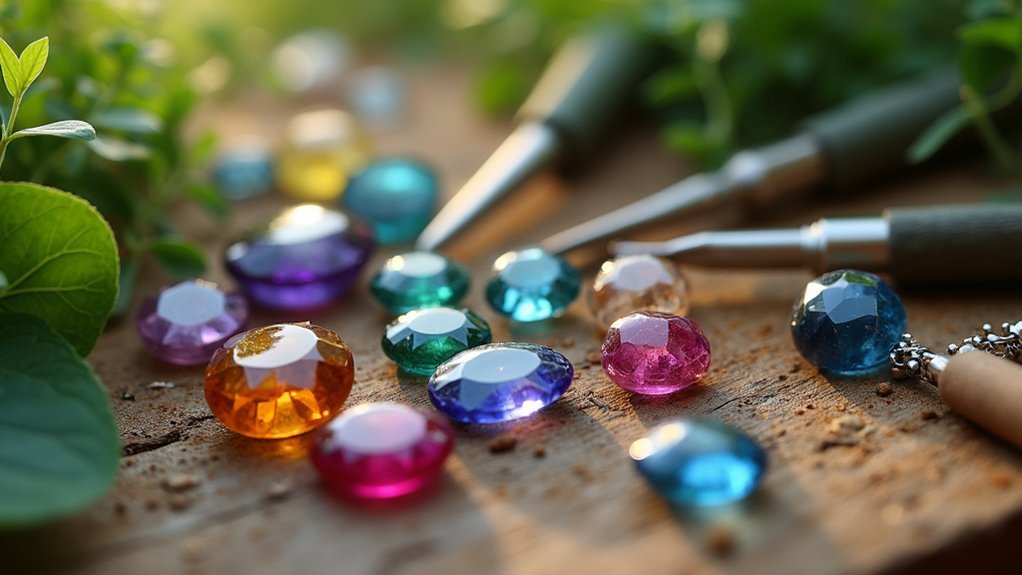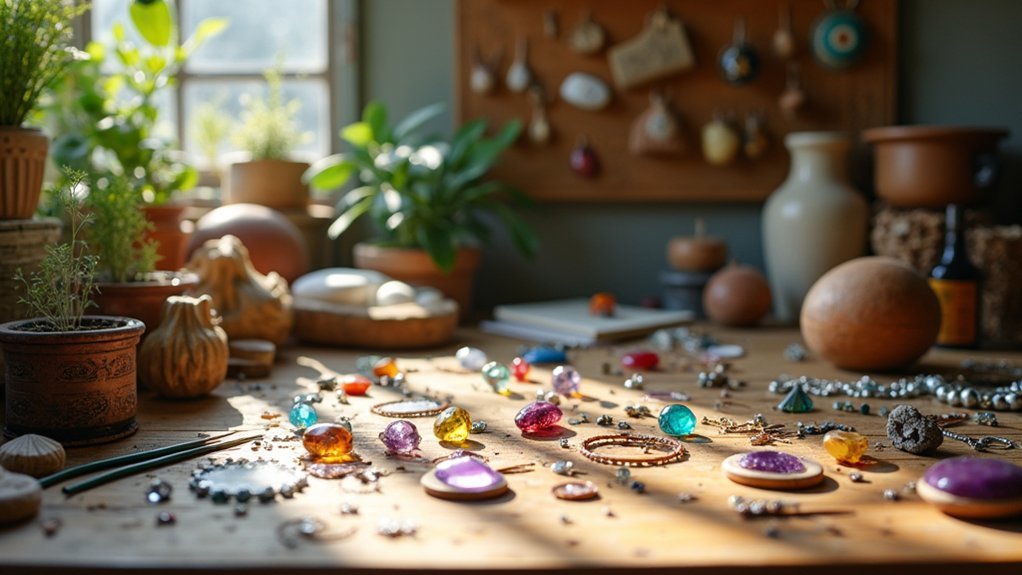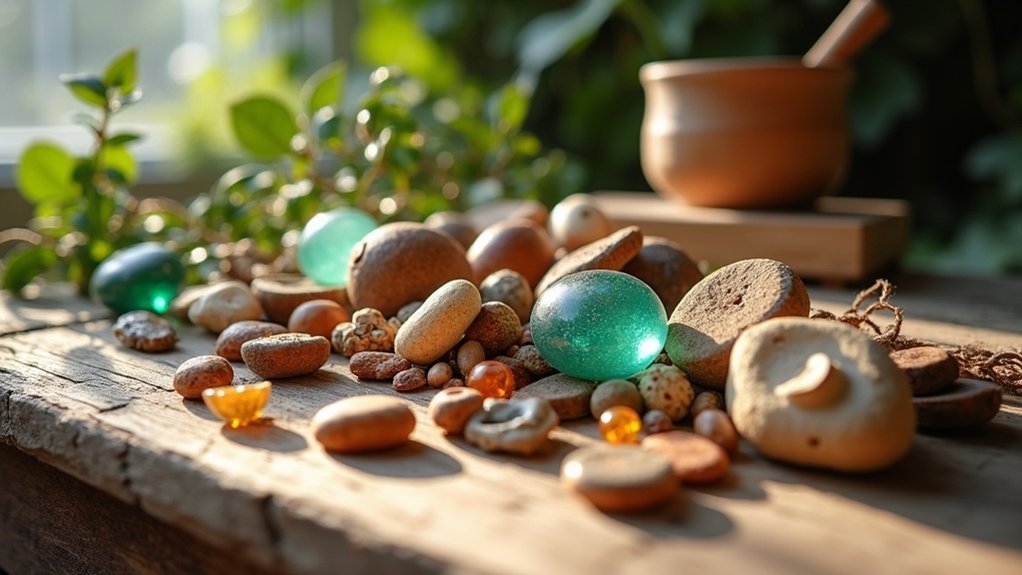You’ve probably noticed how traditional jewelry making can be surprisingly harsh on the environment. From mining practices that devastate landscapes to wasteful production methods that generate excessive scrap metal, the industry’s impact runs deeper than most creators realize. But there’s a growing movement among artisans who’re proving you don’t have to choose between beautiful craftsmanship and environmental responsibility. The key lies in understanding which sustainable practices actually make a difference.
Source Recycled and Ethically-Mined Metals for Your Jewelry Projects

When you’re starting your eco-friendly jewelry making journey, your choice of metals forms the foundation of truly sustainable creations.
Prioritize sourced recycled metals like Fairmined silver and gold, which dramatically reduce environmental impact compared to newly mined alternatives. Research suppliers thoroughly to guarantee transparency in their sourcing practices, focusing on those committed to ethical mining and community reinvestment initiatives.
Choosing Fairmined metals over newly mined alternatives creates immediate environmental benefits while supporting ethical sourcing and community development.
Consider reclaimed metals from old jewelry or scrap to support the circular economy while minimizing waste. Look for certifications like Fairtrade Gold and Responsible Jewelry Council to verify your sustainable materials meet ethical standards.
Explore local suppliers for recycled options—this reduces transportation emissions while supporting regional economies. These choices transform your ethical jewelry projects into meaningful contributions toward environmental responsibility.
Minimize Waste Through Proper Scrap Collection and Recovery Techniques
Every fragment of precious metal in your jewelry studio holds value, making efficient scrap collection essential for both environmental and economic sustainability.
Set up a dedicated scrap bin to capture all metal waste during your projects. Even tiny silver filings and dust particles can undergo the refinement process for future use as recycled metals.
Regularly sweep your workspace to recover valuable metal particles that accumulate during filing and polishing. This systematic scrap collection considerably reduces your environmental footprint while maximizing material efficiency.
Extend waste reduction beyond metals by collecting all waste materials, including used paper towels.
Reuse packaging materials like plastic bags and boxes for storage and shipping. Purchase eco-friendly materials from sustainable suppliers to support responsible sustainable jewelry making practices that reduce overall waste production.
Choose Lab-Grown Gems and Responsibly-Sourced Stones

Beyond managing metal waste effectively, your gemstone choices present another powerful opportunity to create sustainable jewelry.
Lab-grown gems and responsibly-sourced stones greatly reduce environmental impact through sustainable methods that use 90% less energy than traditional mining.
Lab-grown and ethically-sourced gemstones slash environmental impact by using 90% less energy than conventional mining operations.
When selecting stones, prioritize these ethical sourcing options:
- Lab-grown diamonds – offering a carbon footprint 1/20th that of mined alternatives
- Fairmined certified gems – guaranteeing fair labor practices and community support
- Fairtrade stones – ensuring environmental sustainability throughout extraction
- Verified ethical suppliers – adhering to strict social responsibility standards
These eco-friendly alternatives appeal to consumers demanding ethical practices while supporting responsible mining communities.
As jewelry makers, you’ll reduce your carbon footprint substantially while meeting growing market demand for sustainably-created pieces that don’t compromise on beauty or quality.
Implement Sustainable Studio Practices and Eco-Friendly Tools
Creating an environmentally responsible jewelry studio requires implementing systematic practices that minimize waste and reduce your ecological footprint.
Start by establishing a thorough scrap bin system to collect all precious metals waste, ensuring even tiny particles get refined and reused within the circular economy.
Replace traditional acidic solutions with citric-acid-based pickles and other eco-friendly materials that create safer working conditions while reducing toxicity.
Prioritize sourcing 100% recycled silver and gold, as mining generates up to 20 tons of waste per ounce of gold extracted.
Embrace small-batch production techniques to limit excess material usage and decrease energy consumption.
Complete your sustainable jewelry studio transformation by investing in eco-friendly shipping materials and packaging, eliminating plastic waste while reinforcing your environmental commitment throughout your entire business operation.
Partner With Local Artisans to Support Community-Based Production

When you partner with local artisans, you’ll transform your jewelry making into a community-centered practice that preserves traditional craftsmanship while reducing your environmental impact.
These collaborations create environmentally friendly production cycles while fostering meaningful community bonds through shared creativity and knowledge exchange.
Working with nearby creators offers multiple advantages for small-batch jewelry makers:
- Enhanced transparency – You’ll maintain complete visibility over your supply chain and ethical sourcing practices.
- Reduced emissions – Local partnerships eliminate long-distance transportation requirements.
- Fair labor standards – Small-scale producers typically employ sustainable methods over mass production tactics.
- Cultural innovation – Collaborative efforts yield creative designs that reflect authentic local traditions.
Frequently Asked Questions
How Do You Make Jewelry Eco-Friendly?
You’ll make jewelry eco-friendly by using recycled metals, upcycling old pieces, sourcing ethical gemstones, creating small batches, minimizing waste, choosing renewable energy, and implementing sustainable packaging practices throughout your entire production process.
What Is the Most Ethical Material for Jewelry?
You’ll find recycled metals like gold and silver are the most ethical jewelry materials. They drastically reduce mining waste and environmental damage while maintaining quality and beauty for your pieces.
Can Jewelry Be Eco-Friendly?
You can definitely make jewelry eco-friendly by choosing recycled metals, upcycled materials, and ethically sourced gemstones. You’ll reduce environmental impact through sustainable packaging and small-batch production methods that minimize waste.
What Are the Environmental Issues With Jewelry?
You’ll find jewelry production devastates environments through mining that destroys habitats, pollutes water with toxic chemicals like mercury, generates massive waste, contributes greenhouse gases, and exploits children in dangerous working conditions.
In Summary
You’ve got the foundation to transform your jewelry making into an environmentally conscious practice. By sourcing recycled metals, implementing smart waste recovery, choosing sustainable gems, upgrading your studio practices, and partnering with local artisans, you’re creating beautiful pieces while protecting the planet. Start with one or two changes that feel manageable, then gradually incorporate the remaining practices. Your commitment to eco-friendly small-batch production makes a meaningful difference in the jewelry industry’s environmental impact.





Leave a Reply